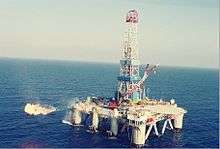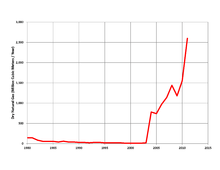Natural gas in Israel


Natural gas in Israel is a primary energy source in Israel. As of 2014, Israel produced over 7.5 billion cubic meters (bcm) of natural gas a year[1] and exported natural gas only to the Palestinian territories.[2] Israel had over 285 billion cubic meters (cu m) of proven reserves of natural gas as of 2014.[3]
History

Historically, Israel relied on external imports for meeting most of its energy needs, spending an amount equivalent to over 5% of its GDP per year in 2009 on imports of energy products.[4] The transportation sector relies mainly on gasoline and diesel fuel, while the majority of electricity production is generated using imported coal. As of 2013, Israel was importing about 100 mln barrels of oil per year.[5] The country possesses negligible reserves of crude oil but does have abundant domestic natural gas resources which were discovered in large quantities starting in 2009, after many decades of previously unsuccessful exploration.[6][7][8][9][10]
Until the early 2000s, natural gas use in Israel was minimal. In the late 1990s, the government of Israel decided to encourage the usage of natural gas because of environmental, cost, and resource diversification reasons. At the time however, there were no domestic sources of natural gas and the expectation was that gas would be supplied from overseas in the form of LNG and by a future pipeline from Egypt (which eventually became the Arish–Ashkelon pipeline). Plans were made for the Israel Electric Corporation to construct several gas-driven power plants, for erecting a national gas distribution grid, and for an LNG import terminal. Soon thereafter, gas began to be located within Israeli territory, first in modest amounts and a decade later in very large quantities located in deep water off the Israeli coastline. This has greatly intensified the utilization of natural gas within the Israeli economy, especially in the electrical generation and industrial sectors, with consumption growing from an annual average of 9,900,000 m3 (350×106 cu ft) between 2000 and 2002 to 3.7×109 m3 (129×109 cu ft) in 2010.[7]
| 2004 | 2005 | 2006 | 2007 | 2008 | 2009 | 2010 | 2014 | 2016* | 2018* | 2020* | 2022* | 2024* | 2026* | 2028* | 2030* |
|---|---|---|---|---|---|---|---|---|---|---|---|---|---|---|---|
| 1.2 | 1.6 | 2.3 | 2.7 | 3.7 | 4.2 | 5.2 | 7.6 | 9.5 | 10.1 | 11.1 | 11.7 | 13 | 14.3 | 15.3 | 16.8 |
| Figures are in Billion Cubic Meters (BCM) per year . *Estimated. | |||||||||||||||
Gas discoveries


In 2000, a modest discovery was made when a 33-billion-cubic-metre (BCM), or 1,200-billion-cubic-foot, natural-gas field was located offshore Ashkelon, with commercial production starting in 2004. As of 2014 however, this field is nearly depleted—earlier than expected due to increased pumping to partially compensate for the loss of imported Egyptian gas in the wake of unrest associated with the fall of the Mubarak regime in 2011. In 2009, a significant gas find named Tamar, with proven reserves of 223 BCM or 7.9×1012 cu ft (307 BCM total proven + probable) was located in deep water approximately 90 km (60 mi) west of Haifa, as well as a smaller 15 BCM (530×109 cu ft) field situated nearer the coastline.[12][13][14][15] Furthermore, results of 3D seismic surveys and test drilling conducted since 2010 have confirmed that an estimated 621 BCM (21.9×1012 cu ft) natural-gas deposit exists in a large underwater geological formation nearby the large gas field already discovered in 2009.[16][17][18][19] An article in The Economist stated that Israel had "verified" gas finds of 35 trillion cubic feet as of early 2014.[20] The US Energy Information Administration listed Israel as having 7.0 trillion cubic feet of proved reserves as of 1 January 2015.[21]
The Tamar field began commercial production on 30 March 2013 after four years of extensive development works.[22] The supply of gas from Tamar is expected to provide a boost to the Israeli economy, which has suffered losses of more than NIS20 billion between 2011 and 2013 resulting from the disruption of gas supplies from neighboring Egypt (and which are not expected to resume due to Egypt's decision to indefinitely suspend its gas supply agreement to Israel).[23][24] As a result, Israel, as well as its other neighbor Jordan, which also suffered from disruption of gas deliveries from Egypt, had to resort to importing significantly more expensive and polluting liquid heavy fuels as substitute sources of energy. While Egyptian gas supplies to Jordan were partially restored in 2013,[25] supplies from Tamar, and in the future from the Leviathan field, are expected to satisfy all Israeli domestic natural gas needs for decades to come.[7] Moreover, due to the erratic supply of gas from Egypt, Jordan has reportedly been considering signing an agreement to import gas from Israel. While less desirable to the kingdom from a political standpoint, such an agreement represents the most expedient and least costly option for Jordan to compensate for its loss of Egyptian gas.[26][27] The energy shortages in Egypt which led it to curtail its exports of natural gas mean that Egypt too may someday obtain natural gas from Israel, though so far Egypt has rejected such deals on political grounds, despite the fact that procuring gas from Israel would be significantly cheaper than from other sources of imported natural gas.[28]
The large gas discoveries so far have confirmed that the Levant basin of the Eastern Mediterranean contains significant quantities of natural gas and, potentially, crude oil. Consequently, additional exploration for oil and gas off Israel's coastline is continuing.[9][29] A source close to Prime Minister Benjamin Netanyahu has valued Israel's natural gas reserves at $130 billion,[30] while in 2012 BusinessWeek estimated the reserves' value at $240 billion.[31] The businesses involved in exploration aim to export a share of future production, but others argue that it would be preferable, on geopolitical grounds, to use the gas within the country instead of other energy sources.[32] In early 2012 the Israeli cabinet announced plans to set up a sovereign wealth fund (called "the Israeli Citizens' Fund") that would allocate part of the royalties from energy exploration to education, defense and overseas investments.[33]
| Field[34] | Discovered | Production | Estimated size |
|---|---|---|---|
| Noa North | 1999[35] | 2012 | 50 billion cubic feet |
| Mari-B | 2000 | 2004 | 1 trillion cubic feet |
| Tamar | 2009 | 2013 | 10.8 trillion cubic feet[15] |
| Dalit | 2009 | Not in production | 700 billion cubic feet |
| Leviathan | 2010 | Not in production | 22 trillion cubic feet |
| Dolphin | 2011 | Not in production | 81.3 billion cubic feet[36] |
| Tanin | 2012 | Not in production | 1.2–1.3 trillion cubic feet |
| Karish | 2013 | Not in production | 2.3–3.6 trillion cubic feet |
Power stations
List of Natural gas-fired power stations in Israel:
- Dalia Power Station
- Dorad Power Station
- Eshkol Power Station
- Mishor Rotem Power Station
- Reading Power Station
See also
References
- ↑ CIA. The World Factbook. Natural gas - production.
- ↑ http://atlas.media.mit.edu/en/visualize/tree_map/hs92/export/isr/show/271111/2014/
- ↑ https://www.cia.gov/library/publications/the-world-factbook/rankorder/2253rank.html#is
- ↑ Asa-El, Amotz (27 January 2009). "Gas discovery tempers Israeli recession blues". MarketWatch. Retrieved 17 October 2012.
- ↑ Israel's Key Energy Statistics - Energy Information Administration site
- ↑ Buck, Tobias (31 August 2012). "Field of dreams: Israel's natural gas". Financial Times Magazine. Retrieved 2 September 2012.
- 1 2 3 "Oil and natural gas in the Eastern Mediterranean region (summer 2013 report)". U.S. Energy Information Administration. 15 August 2013. Retrieved 24 August 2013.
- ↑ Levinson, Charles; Chazan, Guy (30 December 2010). "Big Gas Find Sparks a Frenzy in Israel". The Wall Street Journal. Retrieved 1 January 2011.
- 1 2 Bar-Eli, Avi (26 April 2011). "400 Drills in 60 Years: Is there Oil in Israel?". TheMarker (in Hebrew). Retrieved 27 April 2011.
- ↑ Udasin, Sharon (3 July 2012). "New Natural Gas Wealth Means Historic Change for Israel". National Geographic News. part of "The Great Energy Challenge" series. Retrieved 25 August 2012.
- ↑ "Delivery System". Israel Natural Gas Lines, Ltd. Retrieved 24 March 2012.
- ↑ "Delek Group Subsidiaries Announce Preliminary Results of 3D Seismic Survey & Updates on Tamar & Mari-B Fields" (Press release). Delek Group. 3 June 2010. Retrieved 3 June 2010.
- ↑ Bar-Eli, Avi (12 August 2009). "Tamar offshore field promises even more gas than expected". Haaretz. Retrieved 17 October 2012.
- ↑ Scheer, Steven (3 June 2010). "Noble increases Tamar gas reserve estimate 15 pct". Reuters. Retrieved 17 October 2012.
- 1 2 "Tamar Reserves Update". Isramco Negev 2, LP. 1 February 2014. p. 2. Retrieved 2 February 2014.
- ↑ Solomon, Shoshanna; Khan, Sarmad (13 July 2014). "Israel Shares Rise as Gas Field Reserves Are Increased". Bloomberg News. Retrieved 13 July 2014.
- ↑ "Noble Energy Announces Successful Leviathan Appraisal Results and Increases Resource Size" (Press release). Noble Energy. 19 December 2011. Retrieved 28 December 2011.
- ↑ "Significant Discovery Announced at Leviathan-1" (Press release). Delek Group. 29 December 2010. Retrieved 30 December 2010.
- ↑ Barkat, Amiram; Koren, Hillel (1 May 2013). "Leviathan gas reserves raised again". Globes. Retrieved 1 May 2013.
- ↑ http://www.economist.com/news/middle-east-and-africa/21595039-obstacles-still-block-flow-oil-and-gas-eastern-mediterranean-too Israel’s and Palestine’s gas and oil: Too optimistic?
- ↑ US Energy Information Administration, Natural gas proved reserves, 2015.
- ↑ Solomon, Shoshanna; Ackerman, Gwen (30 March 2013). "Israel Begins Gas Production at Tamar Field in Boost to Economy". Bloomberg. Retrieved 30 March 2013.
- ↑ Barkat, Amiram (24 December 2013). "Israel in talks to export gas via Egypt". Globes. Retrieved 18 April 2013.
- ↑ Barkat, Amiram (30 March 2013). עצמאות אנרגטית: החלה הזרמת הגז הטבעי ממאגר "תמר"; צפוי להגיע לישראל תוך 24 שעות [Energy Independence: Gas from Tamar Expected to Arrive in 24 Hours]. Globes (in Hebrew). Retrieved 30 March 2013.
- ↑ "Egyptian gas supply to Jordan stabilises at below contract rate". Al-Ahram. 3 June 2013. Retrieved 16 June 2013.
- ↑ "Energy-poor Jordan faces explosive electricity hikes". UPI. 11 July 2013. Retrieved 12 July 2013.
- ↑ Said, Summer (29 January 2014). "BP's Risha Exit Means Slim Pickings for Jordan's Energy Needs". The Wall Street Journal. Retrieved 5 February 2014.
- ↑ "Egypt says not interested in Israeli gas as plans LNG imports". Reuters. 23 October 2013. Retrieved 16 November 2013.
- ↑ Zeno, Lior (10 May 2011). "Two Weeks' Postponement in Pelagic's Drilling License Approval". TheMarker. Retrieved 21 May 2011.
- ↑ Barkat, Amiram (19 February 2012). "'Israel's gas reserves worth $130b'". Globes. Retrieved 20 February 2012.
- ↑ Gismatullin, Edward; Ben-David, Calev (2 August 2012). "Israel Finds $240 Billion Gas Hoard Stranded by Politics: Energy". BusinessWeek. Retrieved 3 August 2012.
- ↑ Trilnick, Itai (8 February 2012). "Don't export gas, think tank urges Israeli leaders". Haaretz. Retrieved 17 October 2012.
- ↑ Shemer, Nadav; Udasin, Sharon (19 February 2012). "Cabinet outlines plan for sovereign wealth fund". Jerusalem Post. Retrieved 20 February 2012.
- ↑ Israel’s Natural Gas Bonanza. Energy Tribune. Retrieved on 8 September 2011.
- ↑ Beckwith, Robin (March 2011). "Israel's Gas Bonanza" (PDF). Journal of Petroleum Technology: 46. Retrieved 5 February 2012.
- ↑ Yeshayahou, Koby (12 February 2012). "Dolphin gas field estimate cut by 85%". Globes. Retrieved 26 July 2012.